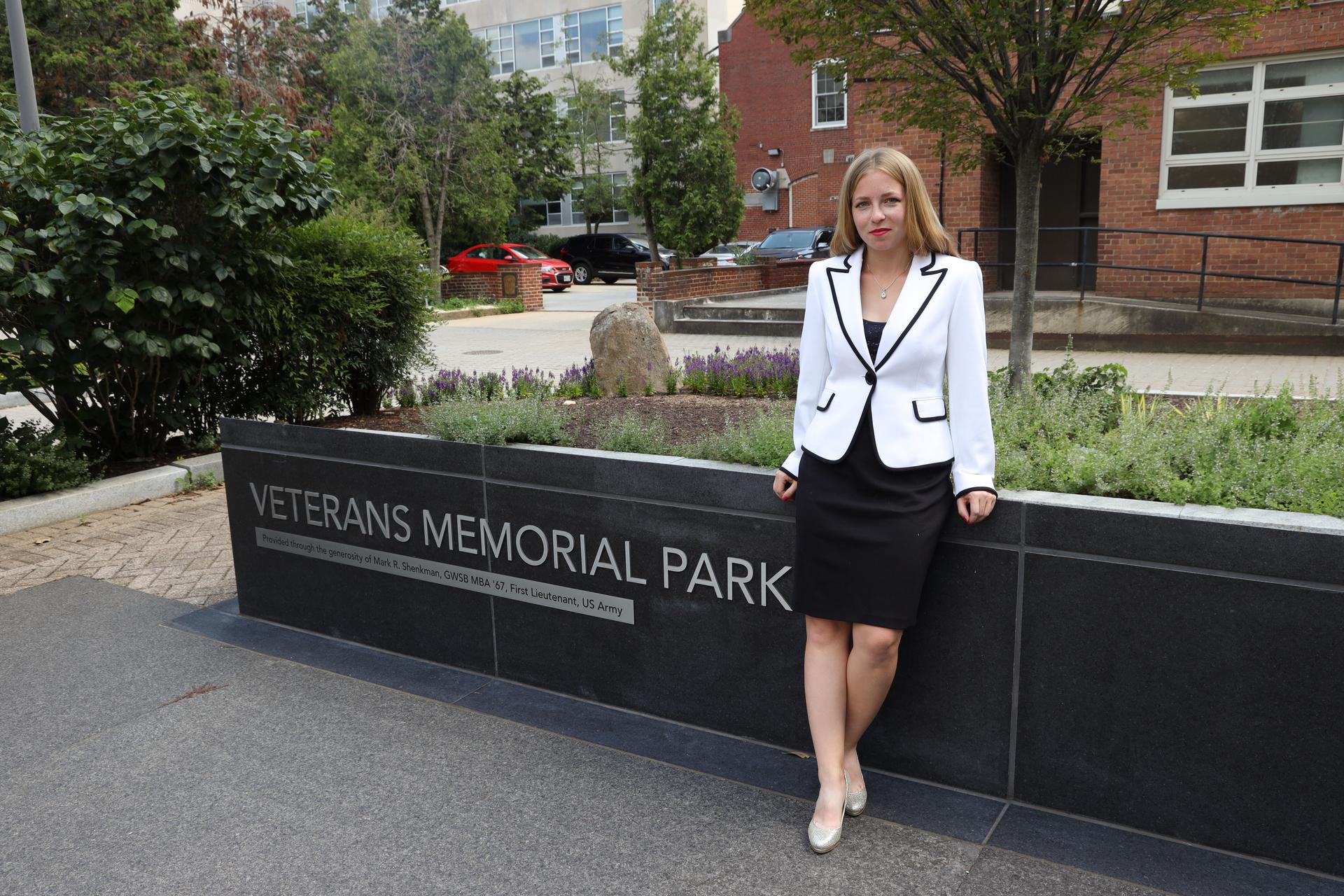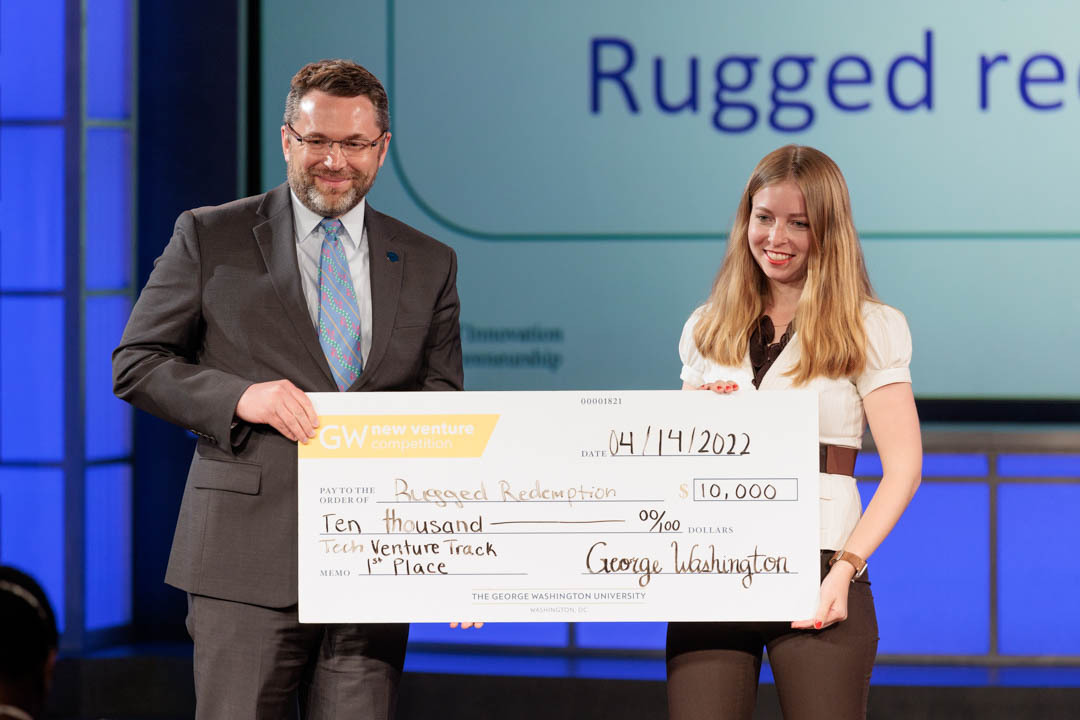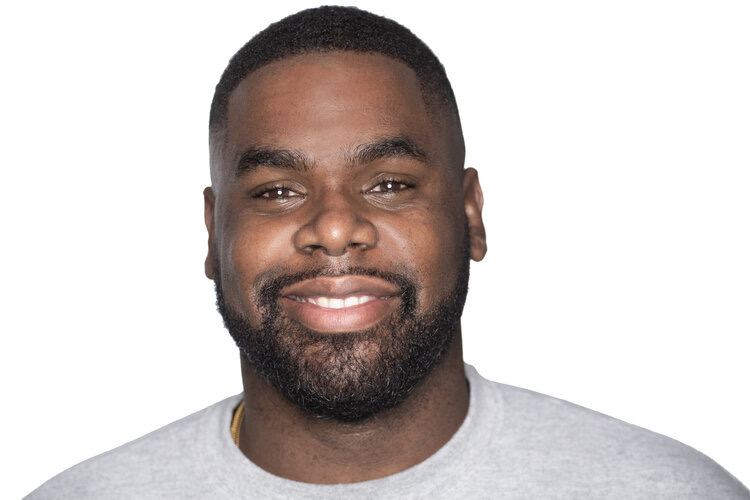The steps George Washington University biomedical engineering alumna Sarah Malinowski, M.S. ’23, took to walk across the Polish border and into Ukraine were second nature.
They’d be anything but routine, though, for the people she was going to see. Changing that was precisely why she was there.
In June, Malinowski brought her prosthetic knee prototype—called Rugged Redemption—to hospitals in Ukraine, where Russian invasion has devastated the country with war for the past two years. There, she’d meet with amputees who had lost their legs as a result the war and just wanted to feel some sense of normalcy—the way it was before that fateful night in February 2022 that marked the start of the invasion.
Returning to normal is also the entire basis of the prototype Malinowski has spent years meticulously developing for active transfemoral amputees, especially veterans, to regain their lifestyle without having to manually change or adjust their artificial knee so the activities they’ve done all their lives can once again become habitual.
To truly get a sense of Rugged Redemption’s need, Malinowski decided to venture to the part of the world where “normal” has been so intensely interrupted.
Answers to questions
While working at a prosthetic clinic during her undergraduate days, Malinowski met a U.S. military veteran who had lost his leg during active duty. That service member, as she vividly recalls, shared the difficulties he suddenly had with what he used to perceive as routine activities.
“Some of those stories just break your heart,” said Malinowski, whose her strong military roots come from her grandfathers, both Army veterans who would take her on base at Minnesota’s Fort Snelling. “It quickly transitioned to ‘what can I do to fix this?’”
She started the preliminary work on the prototype while earning her bachelor’s in mechanical engineering from St. Cloud State University, although the work really started in elementary school when she’d doodle stick figures with prosthetic legs on scratch paper. “I’d have little quote bubbles on them saying ‘thanks for prosthetic,’” she admits with a laugh.
Malinowski chose to pursue her master’s degree in biomedical engineering at GW because she could continue working on the model. Not to mention, she was drawn to GW’s prevalence of veterans and organizations dedicated to them.
Thanks to mentors such as School of Engineering and Applied Science Associate Professor Chung Hyuk Park and I-Corps Director Bob Smith of the Office of Innovation and Entrepreneurship, Malinowski spent her time at GW honing the prototype and learning how to present it to potential funders. The OIE office became her secondary home as she pored over Rugged Redemption’s nitty-gritty details.
“There are certain characteristics we look for in an entrepreneur—there’s an organized way of thinking, drive and not being satisfied with simple answers,” Smith said. “Sarah exhibited all of that. She is methodical, detail oriented and execution focused.”
In fact, Rugged Redemption won the Tech Venture Track at the 2022 New Venture Competition, where Malinowski totaled $27,500 worth of prize money that helped her pay for a provisional patent.
But as she kept pitching to investors, one central question kept arising: How great is this need, especially among veterans and military personnel?
“I was going to need to know this answer if I was going to start my own company,” said Malinowski, who named her startup company Seamless Transition, LLC.
She decided that perhaps the best answer lay in Eastern Europe.
On the front lines
In January, Malinowski and her CFO, GW M.B.A. student Chelsea Sutch, booked an Airbnb in Krakow, Poland, where many Ukrainian refugees were living. She envisioned talking to as many refugees as possible to get their firsthand accounts of the situation in Ukraine and need for prosthetic legs.
“What’s happening right now in Ukraine [is] what modern warfare looks like,” Malinowski said, citing IEDs, border mines and weapons aid from other nations.
But her itinerary grew when a Green Beret friend of hers offered a connection that could get her inside the Ukrainian border—Lviv specifically. She could go straight the source. Malinowski eagerly accepted, with one warning from her friend: Be sure you’re mentally prepared for what you are going to see.
“I knew it wasn’t going to be rainbows and butterflies, so I was about as prepared as I was ever going to be,” Malinowski said. And off she went solo—where she got off the bus on the Polish side of the border and crossed into Ukraine by foot, showing proof of intent at the gate covered in barbwire.
Her leap of faith paid off. A Ukrainian woman roughly her age, who served as translator, and the woman’s father were waiting in a van just on the other side as promised. They drove down roads with military trucks and tanks on either side as well as blockades in the road. This was real.
Malinowski spent most of her time in Ukraine at hospitals, where she met with both directors and patients. And what she learned was startling.
The Human Rights Campaign estimates that landmines have been documented in 11 of Ukraine’s 27 regions. In the same report, Ukrainian Prime Minister Denys Shmyhal stated in April 2023 that about 174,000 square kilometers of Ukrainian land is now contaminated with explosive objects.
The hospital directors told Malinowski that once a week, a military truck drops off anywhere from 100 to 200 patients, and 60% of them need above-the-knee amputations. The demand for prosthetics far outnumbers the supply.
“There’s more of a need than I ever could have imagined,” Malinowski said.
Malinowski approached patients still wrestling with PTSD from blasts that mangled their lower bodies and asked about their daily activities at home and what they were most looking forward to when leaving the hospital. This gave her more of a sense of what capabilities to consider for her own prototype.
“I talked with someone who loved gardening. They want to bend down and get on their knees to water their plants. They want to be able to take a little jog with their dog if they can,” Malinowski said. “These are people whose lives have been completely uprooted, but they truly just want to go back to living their everyday life unbothered.”
The path ahead
The knee is one of the body’s most complex parts, with four bones that make up three separate joints that all work together to allow movement. Many prosthetics on the market, Malinowski says, do not provide the mobility necessary to both walk and run, cross uneven terrain, scale inclines or quickly switch between activities without changing prosthetics.
Malinowski has heard firsthand through years of market research, including her time in Ukraine, that these limitations prevent active-duty service members from meeting retention standards and returning to duty. She sees Rugged Redemption being a solution and is constantly tinkering with the design so that it will allow the wearer to run, walk and more without switching prosthetics.
She compares her design to a car’s suspension system of tires, springs, shock absorbers and linkages that connect the wheel allowing relative motion between the two.
“If somebody can upscale it to a car, then we can downscale it to a human,” Malinowski describes.
Once it moves from small- to full-scale prototyping, Seamless Transition, LLC will begin the FDA approval process for Rugged Redemption. The hospital directors she met in Ukraine have already volunteered themselves to test the product, which Malinowski sees as a win-win: More amputees in Ukraine can access prosthetics they need, while she can collect testing data. And after meeting the needs of the military and veteran communities, Malinowski sees Seamless Transition expanding to all amputees.
As she spent time in Ukraine, where children playing at the parks and local coffee shops bustling with customers coincided with warning sirens ringing throughout Lviv, she couldn’t help but notice the normalcy among chaos.
“They live every day not knowing if it’s their last,” she said. “They just want to go back to what they were doing and what they had.”
The attitudes she saw in proud Ukrainians, including amputee soldiers, further intensified the passion she’s had since her doodling days of elementary school. As Malinowski has learned throughout this entire process, getting back to “normal” sometimes requires the extraordinary.







